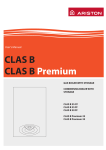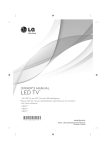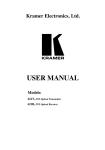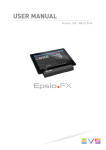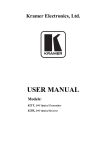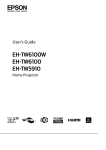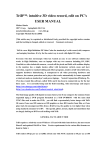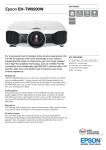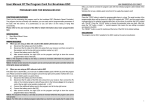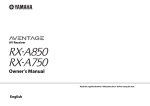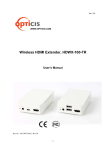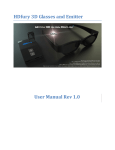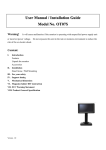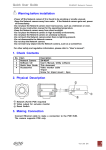Download Wireless 60G HD Transceiver User manual
Transcript
Wireless 60G HD Transceiver User manual Thank you for purchasing this product. For optimum performance and safety, please read the instruction carefully before connecting, operating or adjusting this product. Please keep the manual for future reference. 1. Introduction Wireless 60G HD Transceiver include Transmitter and Receiver, it extender system sends high definition video and audio to any HDTV display up to 20 meters. It supports resolutions up to 1080p Full HD, 3DTV, CEC, and 7.1-channels of High Bit Rate (HBR) lossless digital audio such as Dolby TrueHD, DTS-HD Master Audio. The Wireless 60G HD is specifically designed to transmit within a room. 2. Features Supports video resolutions: VGA through WUXGA 480i/576i to 1080p@60Hz 3D video support 1080p/720p WiHD 1.1 Compliant Compliant with HDMI1.4,HDCP2.0 Supports Dolby TrueHD, DTS-HD Master Audio and LPCM digital audio streams up to 7.1channels Uncompressed High Definition A/V from source to display Near zero latency Wireless extension of HDMI up to 30 meters Support for CEC commands 3. Package 1. 2. 3. 4. 5. Wireless 60G HD Transmitter --------------------------------------- 1PCS Wireless 60G HD Receiver ------------------------------------------- 1PCS 5V/1A USB adaptor ------------------------------------------------------ 2PCS Operation Manual ------------------------------------------------------ 1PCS USB to Micro-USB Cable-----------------------------------------------2PCS Ver1.0 Page 1 4. Specifications Frequency Band Range:: Input resolution (Transmitter): Output resolution (Receiver): Input ports (Transmitter): Output ports (Receiver): USB Connector (Transmitter/ Receiver): Dimensions (mm): Wight (g): Operating Temperature: Storage Temperature: Humidity: Power Consumption (Max): 60 GHz up to 1080P@60Hz up to 1080P@60Hz 1x HDMI (Female type) 1x HDMI (Female type) Micro USB 90(W) x 56(D) x 17(H) 0°C ~ 40°C / 32°F ~ 104°F -20°C ~ 60°C / -4°F ~ 140°F 20 ~ 90% RH (Non-condensing) 3.5W 5. Operation controls and Functions Transmitter Front View Ver1.0 Page 2 Receiver Front View 1. Power LED: illuminates when power has been supplied to the unit. 2. Link LED: The connection status indicating lamp. LED OFF: Means the adapter is powered OFF or in Sleep mode. LED Slow Blink: Means the adapter has started radio transmission and has not yet found the other side of the link: If the adapter is a transmitter, the adapter is in Scan mode, searching for a matching receiver. If the adapter is a Receiver, the adapter is in Beacon mode, searching for a matching transmitter. LED Fast Blink: Means the adapters are associated, which means that the receiver and transmitter have accepted each other and established a network. LED ON: Means the transmitter and receiver adapters have established an audio/video connection. At this point, the user should be able to see this transmission happening on the display attached to the receiver. Ver1.0 Page 3 Transmitter Rear Panel 1. HDMI IN: This slot is where you connect the HDMI source. 2. POWER: Plug the 5V DC power supply into the unit or connect to the source USB port via USB to Micro-USB cable. 3. Button: The button has a variety functions. Wakeup Function: If the adapter is in Sleep mode (Status LED is OFF and power supply is connected), pressing this button will wake up the adapter and start normal operation. Set to Factory Default Function: At any point, a long press (ten seconds) on the button will reset the adapter to factory default. Next Network Function: When the button is short pressed on the transmitter side, the adapter will give up the current associated network and will join the next available network. User Case Example: One transmitter is connected to a receiver attached to a display, while another TV is connected to another receiver in the room. The user wants to send the audio and video to the other display. To accomplish this, pressing the button of the transmitter will cause it to switch from its current TV display to the other display. Every time the user presses the button, the transmitter will attempt to connect to the next available receiver in the room. A maximum of ten receivers can be supported in the same room. Note that pressing the button on the transmitter side will always interrupt the current audio/video connection such that the transmitter can search for another network, even if none are available. If only one network is available in the room, the Ver1.0 Page 4 transmitter will eventually return to its only network and restablish a video connection with it after finishing its search. Receiver Rear Panel 1. HDMI OUT: This slot is where you connect to a HDMI equipped TV or monitor. 2. POWER: Plug the 5V DC power supply into the unit or connect to the source USB port via USB to Micro-USB cable. 3. Button: The button has a variety functions. Wakeup Function: If the adapter is in Sleep mode (Status LED is OFF and power supply is connected), pressing this button will wake up the adapter and start normal operation. Set to Factory Default Function: At any point, a long press (ten seconds) on the button will reset the adapter to factory default. Next Source Function: When the button is short pressed on the receiver side, and if other transmitter sources are available in its network, the receiver will give up the current video connection and connect with the next available source. User Case Example: Two or more transmitters are in the room and are associated with one receiver attached to a display. The user is currently receiving video from one of the available sources, but wants to switch to another source. To accomplish this, pressing the button of the receiver will cause it to switch from its current audio/video source to the next available source. Every time the user presses the button, the receiver will attempt to connect to the next available transmitter in the room. A maximum of 16 transmitters can be supported in the network. Ver1.0 Page 5 Note that pressing the button on the receiver will not interrupt the current audio/video connection if there is no other transmitter available in the network. In that particular case, the button will do nothing. 6. Supported Video and Audio Formats Supported Video Formats Resolution Refresh Rate (Hz) 640 x 480p (VGA) 60 RGB 4:4:4 (8 bits) 848 x 480 (WVGA) 60 RGB 4:4:4 (8 bits) 800 x 600 (SVGA)) 60 RGB 4:4:4 (8 bits) 1024 x 768 (XGA) 60 RGB 4:4:4 (8 bits) 1280 x 1024 (SXGA) 60 RGB 4:4:4 (8 bits) 1680 x 1050 (WSXGA+) 60 RGB 4:4:4 (8 bits) 1920 x 1200 (WUXGA) 60 RGB 4:4:4 (8 bits) 60 RGB 4:4:4 (8/10/12 bits) YCbCr 4:4:4 (8/10/12 bits) YCbCr 4:2:2(8 bits) 60 RGB 4:4:4 (8/10/12 bits) YCbCr 4:4:4 (8/10/12 bits) YCbCr 4:2:2(8 bits) 50 RGB 4:4:4 (8/10/12 bits) YCbCr 4:4:4 (8/10/12 bits) YCbCr 4:2:2(8 bits) 50 RGB 4:4:4 (8/10/12 bits) YCbCr 4:4:4 (8/10/12 bits) YCbCr 4:2:2(8 bits) 480i 480p 576i 576p Color Depth(Color Depth (8, 10, 12 bits)) Ver1.0 Page 6 50/60 RGB 4:4:4 (8/10/12 bits) YCbCr 4:4:4 (8/10/12 bits) YCbCr 4:2:2(8 bits) 50/60 RGB 4:4:4 (8/10/12 bits) YCbCr 4:4:4 (8/10/12 bits) YCbCr 4:2:2(8 bits) 24/50/60 RGB 4:4:4 (8/10/12 bits) YCbCr 4:4:4 (8/10/12 bits) YCbCr 4:2:2(8 bits) 720p 1080i 1080p Supported 3D Formats Type Resolution Frame Packing Top - Bottom Side-by-Side Refresh Rate(Hz) 1080p 24 720p 50/60 1080p 24 720p 50/60 1080i 50/60 Supported Audio Formats Format Channel Sampling Rates (KHz) LPCM 2 32/44.1/48/88.2/96/176.4/192 LPCM 6/8 32/44.1/48/88.2/96 2/5.1 48 2/5.1/6.1/7.1 48 Dolby TrueHD 5.1/6.1/7.1 48/96 DTS-HD Master Audio 5.1/6.1/7.1 48/96 DTS-HD Master Audio 2/5.1 192 Dolby Digital Dolby Digital Plus Ver1.0 Page 7 7. Application Example Ver1.0 Page 8









